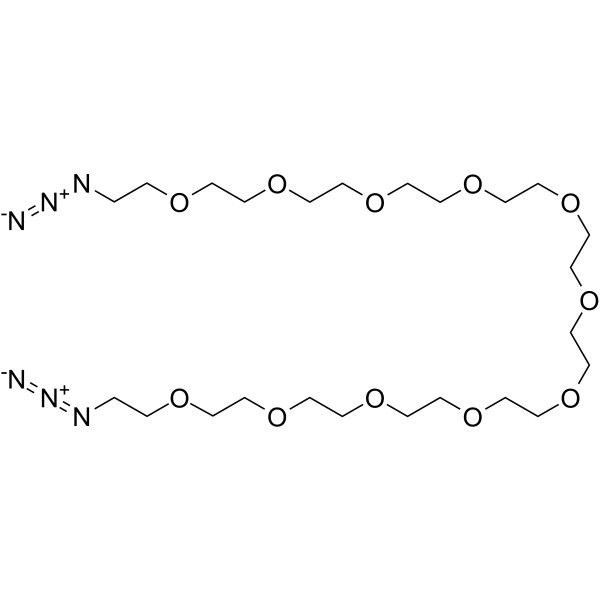
Azido-PEG11-azide
CAS No. 1392284-57-9
Azido-PEG11-azide( —— )
Catalog No. M26892 CAS No. 1392284-57-9
Azido-PEG11-azide is a PEG-based PROTAC linker that can be used in the synthesis of PROTACs.
Purity : >98% (HPLC)
 COA
COA
 Datasheet
Datasheet
 HNMR
HNMR
 HPLC
HPLC
 MSDS
MSDS
 Handing Instructions
Handing Instructions
| Size | Price / USD | Stock | Quantity |
| 5MG | 129 | Get Quote |


|
| 10MG | 178 | Get Quote |


|
| 25MG | 317 | Get Quote |


|
| 50MG | 392 | Get Quote |


|
| 100MG | 514 | Get Quote |


|
| 500MG | 1125 | Get Quote |


|
| 1G | Get Quote | Get Quote |


|
Biological Information
-
Product NameAzido-PEG11-azide
-
NoteResearch use only, not for human use.
-
Brief DescriptionAzido-PEG11-azide is a PEG-based PROTAC linker that can be used in the synthesis of PROTACs.
-
DescriptionAzido-PEG11-azide is a PEG-based PROTAC linker that can be used in the synthesis of PROTACs.(In Vitro):PROTACs contain two different ligands connected by a linker; one is a ligand for an E3 ubiquitin ligase and the other is for the target protein. PROTACs exploit the intracellular ubiquitin-proteasome system to selectively degrade target proteins.
-
In VitroPROTACs contain two different ligands connected by a linker; one is a ligand for an E3 ubiquitin ligase and the other is for the target protein. PROTACs exploit the intracellular ubiquitin-proteasome system to selectively degrade target proteins.
-
In Vivo——
-
Synonyms——
-
PathwayOthers
-
TargetOther Targets
-
Recptor——
-
Research Area——
-
Indication——
Chemical Information
-
CAS Number1392284-57-9
-
Formula Weight596.679
-
Molecular FormulaC24H48N6O11
-
Purity>98% (HPLC)
-
Solubility——
-
SMILES[N-]=[N+]=NCCOCCOCCOCCOCCOCCOCCOCCOCCOCCOCCOCCN=[N+]=[N-]
-
Chemical Name——
Shipping & Storage Information
-
Storage(-20℃)
-
ShippingWith Ice Pack
-
Stability≥ 2 years
Reference
1.Jung, Hae Yeong, et al. Preparation of benzylidene-?heterocyclic compounds for skin-?whitening, anti-?oxidizing and PPAR activation. WO2012108677A2
molnova catalog



related products
-
Ganoderic acid GS-2
Ganoderic acid GS-2 can inhibit the activity of human immunodeficiency virus -1 protease.
-
4-Hydroxybenzoic aci...
4-Hydroxybenzoic acid is a monohydroxybenzoic acid, a phenolic derivative of benzoic acid. It is a white crystalline solid that is slightly soluble in water and chloroform but more soluble in polar organic solvents such as alcohols and acetone.
-
Diosmin Impurity 5
Diosmin analog. Reference standards.



 Cart
Cart
 sales@molnova.com
sales@molnova.com


